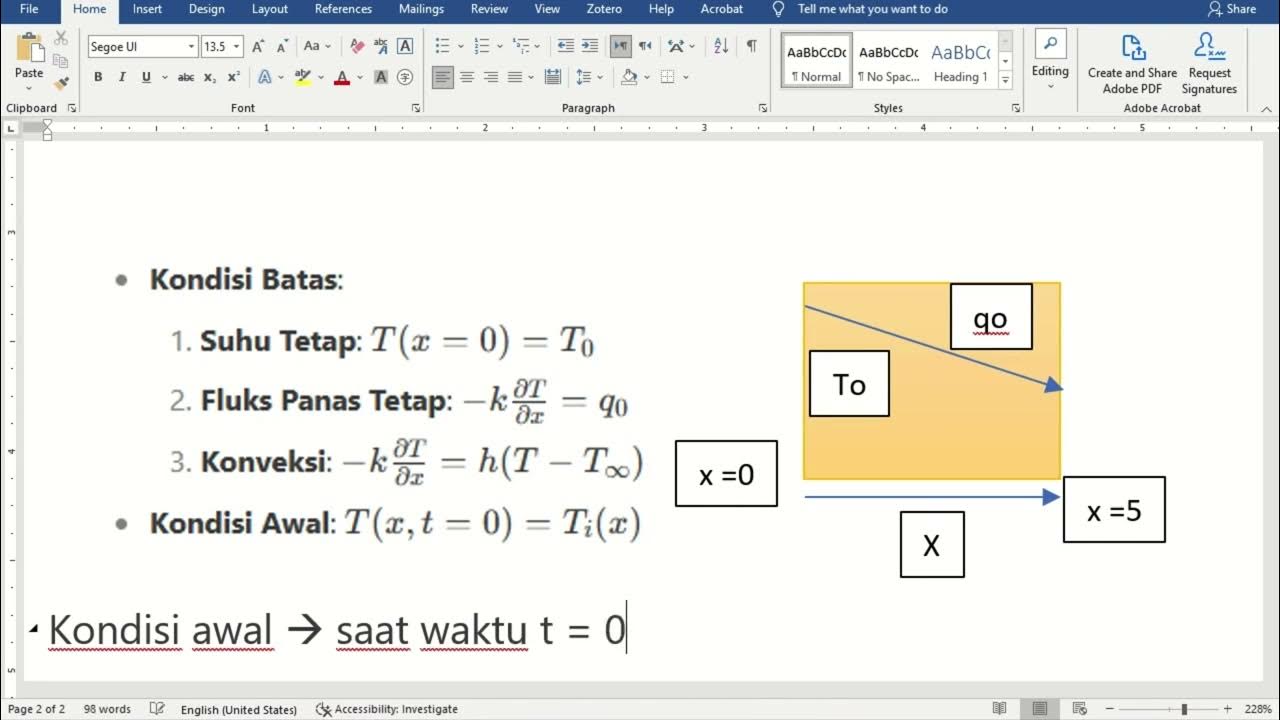Final report-Thermal Conduction
Summary
TLDRThis script delves into the fundamental concepts of thermal conduction, a critical process in engineering and materials science. It introduces thermal conductivity (denoted by K) and its types, including steady-state, transient, relativistic, and quantum conduction. The script explains the physical mechanism behind heat transfer through Fourier's law, leading to the heat equation. It discusses the method of separation of variables for solving the heat equation with boundary and initial conditions, and concludes with practical applications, such as in building energy efficiency, material science, electronic devices, and materials processing.
Takeaways
- 🔥 Thermal conduction is the process of heat transfer from a hotter to a colder part of an object.
- 🌡️ Thermal conductivity (denoted by K) measures an object's ability to conduct heat and is crucial in engineering fields like materials science and electronics design.
- 📈 There are different types of thermal conduction, including steady-state, transient, relativistic, and quantum conduction.
- 🔧 The physical mechanism of thermal conduction involves the transfer of kinetic energy between particles, leading to heat flow.
- ⚖️ Fourier's law of heat conduction describes the process mathematically, relating the temperature gradient to the heat flux.
- 📊 The heat equation, derived from Fourier's law, is used to model the distribution of temperature over time and space.
- 📐 The Laplace operator is used in the heat equation to measure the overall curvature of the temperature function.
- 🔄 The method of separation of variables is a technique for solving the heat equation with specific boundary and initial conditions.
- 🏢 Applications of thermal conduction principles include building energy efficiency, material science for developing alloys and composites, and electronic device design to prevent overheating.
- 🛠️ Material processing, such as welding and additive manufacturing, relies on controlling heat flow for quality assurance.
- 📚 The script provides an example of analyzing the temperature distribution in a cubic metal material over time using the heat conduction equation.
Q & A
What is thermal conduction?
-Thermal conduction is the process by which heat is transferred from the hotter end of an object to the colder end. It is a fundamental mechanism in the transfer of heat and plays a crucial role in various engineering fields.
What is the role of thermal conductivity (denoted by K) in thermal conduction?
-The thermal conductivity (K) of an object is its ability to conduct heat. It characterizes how effectively a material can transfer heat and is essential in determining the efficiency of heat transfer processes.
What are the different types of thermal conduction mentioned in the script?
-The script mentions four types of thermal conduction: steady-state conduction, transient conduction, relativistic conduction, and quantum conduction. Each type has distinct characteristics and applications.
How does the temperature difference affect steady-state conduction?
-In steady-state conduction, the temperature difference driving the conduction remains constant over time, meaning that the heat transfer rate does not change.
What is the significance of the heat equation in the context of thermal conduction?
-The heat equation, derived from Fourier's law of heat conduction, describes the process of heat transfer over time and space. It is crucial for understanding and solving problems related to thermal conduction.
Can you explain the concept of thermal diffusivity in the heat equation?
-Thermal diffusivity (α) in the heat equation is a constant that characterizes how quickly heat diffuses through a material. It is related to the material's ability to conduct heat and its density and specific heat capacity.
What is the method of separation of variables used for in solving the heat equation?
-The method of separation of variables is used to solve the heat equation by transforming it into ordinary differential equations. This method is particularly useful when dealing with boundary and initial conditions in heat conduction problems.
What are some real-world applications of the principles of thermal conduction mentioned in the script?
-The script mentions applications in building energy efficiency, material science, electronic devices, and materials processing. These applications utilize the principles of thermal conduction to ensure energy efficiency, develop new materials, prevent overheating in electronics, and control heat flow in manufacturing processes.
How is the boundary condition applied in the example of a rod of length L with a fixed temperature at both ends?
-In the example, the boundary conditions are applied by setting the temperature at the left end of the rod to always be zero and the temperature at the right end to always be Z. These conditions help define the temperature distribution along the rod.
What is the significance of initial conditions in solving the heat equation?
-Initial conditions are crucial as they define the temperature distribution at the starting point in time. They, along with boundary conditions, are used to solve the heat equation and find the temperature distribution that satisfies all given conditions.
Can you provide an example of how thermal conductivity is applied in a practical problem?
-An example given in the script is analyzing the temperature distribution inside a cubic metal material with side length L, given an initial temperature distribution and constant thermal conductivity. The problem involves using the heat conduction equation with specified boundary conditions to understand how the temperature evolves over time.
Outlines

このセクションは有料ユーザー限定です。 アクセスするには、アップグレードをお願いします。
今すぐアップグレードMindmap

このセクションは有料ユーザー限定です。 アクセスするには、アップグレードをお願いします。
今すぐアップグレードKeywords

このセクションは有料ユーザー限定です。 アクセスするには、アップグレードをお願いします。
今すぐアップグレードHighlights

このセクションは有料ユーザー限定です。 アクセスするには、アップグレードをお願いします。
今すぐアップグレードTranscripts

このセクションは有料ユーザー限定です。 アクセスするには、アップグレードをお願いします。
今すぐアップグレード関連動画をさらに表示

Understanding Conduction and the Heat Equation

NGSS Engineering at JPL: MS-ETS1-1

Persamaan transfer kalor konduksi steady state satu dimensi

KALOR DAN PERPINDAHAN KALOR SERTA CONTOH SOAL DAN PENYELESAIANNYA|| Kelas XI SMA || Gasal

LECTURE NOTES: HEAT TRANSFER, CHAPTER II, PART 2

The Physics of Heat: Crash Course Physics #22
5.0 / 5 (0 votes)
